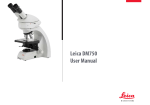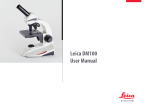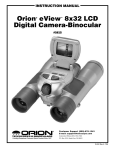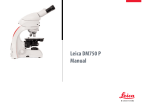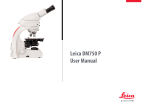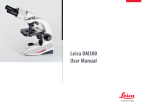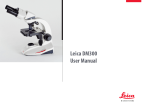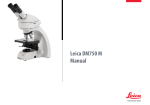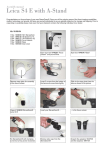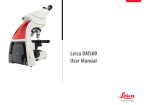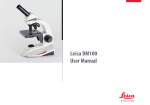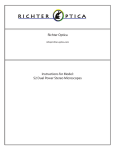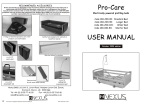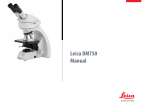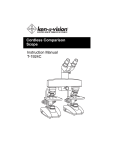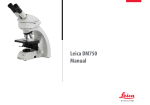Download Leica_DM750M_Manual_EN
Transcript
Leica DM750 M Manual Table of Contents Safety instructions Safety Notes Instructions on use Instructions on use (continued) 3 4 5 6 Assembling the Leica DM750 M 7 Assembling the Incident Light Axis 8 Assembling the Viewing Tubes 9 Leica EZ Viewing Tube with Integrated Eyepieces 10 Leica EZ Viewing Tube – integrated eyepieces (cont.) 11 Leica Standard Tube with Separate Eyepieces 12 Eyecups13 Installing Objectives 14 Conversion to Incident Light Polarization 15 Use16 Switching on the Microscope 17 Modifying the Aperture Diaphragm 18 Illumination Scenarios 19 Illumination Scenarios (continued) 20 Using Specimen Holders 21 Automatic Shutoff of Illumination 22 Leica DM750 M Conversion and Use with Transmitted Light 23 Optional Koehler Illumination 24 Installing the Condenser 25 Installing the condenser (continued) 26 Switching on the Microscope 27 Complete Condenser Centering 28 Complete Condenser Centering (cont.) 29 Using the Condenser 30 Preparation for Viewing a Specimen Slide 31 Focusing32 Viewing Tube Adjustment 33 Viewing Tube Adjustment (cont.) 34 Viewing Tube Adjustment (cont.) 35 Koehler Configuration 36 Koehler Configuration (cont.) 37 Automatic Shutoff of Illumination 38 Care and Repair Instructions Care Instructions Accessories, Maintenance and Repair 39 40 41 Specifications and Dimensions Electrical Data and Ambient Conditions Dimensions (in mm) 42 43 44 Manual 2 Safety instructions Leica DM750 M Manual 3 Safety Notes Before installing, operating or using the instrument, it is mandatory to read this user manual. In particular, please observe all safety instructions. The "Safety Concept" brochure contains additional safety information regarding service work, requirements and the handling of the microscope, the electrical and other accessories as well as general safety instructions. You can combine individual system articles with articles from external suppliers. Please read the user manual and the safety instructions of the supplier. To maintain the unit in its original condition and to ensure safe operation, the user must follow the instructions and warnings contained in these user manuals. Leica DM750 M Warning of a danger This symbol indicates especially important information that is mandatory to read and observe. Failure to follow these instructions may pose hazards to personnel, cause instrument malfunctions or damage the instrument. Hazardous electrical voltage This symbol indicates especially important information that is mandatory to read and observe. Failure to follow these instructions may pose hazards to personnel, cause instrument malfunctions or damage the instrument. EC Declaration of Conformity Electrically operated accessories are constructed based on the state of the art of technology and are provided with an EC Declaration of Conformity. Contact address Leica Microsystems (Schweiz) AG Industry Division Max Schmidheiny Strasse 201 CH-9435 Heerbrugg (Switzerland) Important information This symbol indicates additional information or explanations that intend to provide clarity. Manual 4 Instructions on use Intended use The DM series microscopes by Leica are optical instruments for improving the visibility of objects through magnification and illumination. They are used for observing and documenting. Place of use Use the instrument in enclosed, dust-free rooms at +10 °C to +40 °C only. Protect it from oil, chemicals and extreme humidity. It must be at least 10 cm from the wall and away from flammable substances. Leica DM750 M Interference Avoid large temperature fluctuations, direct sunlight and vibrations. These conditions can distort measurements and micrographic images. Handling electrical components Never install any other plug (NEMA 5-15P) or unscrew any mechanical components unless expressly instructed to do so in the instructions. In warm and warm-damp climatic zones, the individual components require special care in order to prevent the build-up of fungus. The microscope must be connected to a grounded socket. Use in clean rooms Leica DM series microscopes can be used in clean rooms without any problems. Manual Always position the microscope so that you can disconnect it from the power supply at any time. The power cable is provided as the power disconnect device. 5 Instructions on use (continued) Intervention from the user The microscopes of the DM series contain no components that can be maintained or repaired by the user. Exceptions are mentioned specifically in this manual. Unless otherwise specified in this manual, repair and service work may be carried out by authorized Leica technicians only. Unauthorized alterations to the instrument or noncompliant use shall void all rights to any warranty claims. Leica DM750 M Maintenance Leica DM series microscopes are basically maintenance-free. To ensure that it always operates safely and reliably, we recommend that you take the precaution of contacting the responsible service organization. Here you can arrange for periodic inspections and conclude a maintenance contract (recommended). Danger of infection Direct contact with eyepieces is a potential transmission method for bacterial and viral infections of the eye. The risk can be kept to a minimum by using personal eyepieces for each individual or detachable eyecups. Accessories Only those accessories may be used that are listed in this user manual or for which safe use has been confirmed by Leica Microsystems. Manual 6 Assembling the Leica DM750 M Leica DM750 M Manual 7 Assembling the Incident Light Axis Assembly 1. Place the incident light axis with the heat sink facing backwards onto the tripod mount. 3. Fasten the incident light axis into place by tightening the setscrew. 2. Align the incident light axis according to the tripod geometry. Leica DM750 M Manual 8 Assembling the Viewing Tubes There are two types of viewing tube. Identify which viewing tube you have: Assembly 1. Loosen the setscrew (on top of the stand) using the Allen key provided. 2. Set the dovetail into the tripod mount and tighten the setscrew carefully. This way, the tube automatically shifts to the correct position on the optical axis of the microscope. Type 1: Leica EZ Viewing Tube with integrated eyepieces Type 2: Standard tube with separate eyepieces Leica DM750 M Manual 9 Leica EZ Viewing Tube with Integrated Eyepieces 1. In order to use the wingscrew, remove the setscrew that was delivered with the stand. 3. Reinstall the Leica EZ Viewing Tube onto the stand. Leica EZ Viewing Tube with integrated eyepieces Loosen the setscrew at the stand or replace the setscrew with the optional wingscrew to rotate the Leica EZ Viewing Tube. 2. Detach the wing screw part completely before the screw is used on the stand. Leica DM750 M Manual 4. Tighten the wingscrew using the wrench included in the delivery package. 10 Leica EZ Viewing Tube – integrated eyepieces (cont.) Now, you can rotate the Leica EZ Viewing Tube by loosening the wingscrew, bringing the tube to the desired position and tightening the wingscrew again. The eyepieces are integrated into the Leica EZ Viewing Tube and preset; therefore, there is no need to adjust or install the eyepieces. Continue with the "Eyecups" section on page 13. Leica DM750 M Manual 11 Leica Standard Tube with Separate Eyepieces 1. Insert the eyepieces into the tubes. 2. Secure the eyepieces in the tubes by tightening the silver screws at the bottom. Standard tubes; tubes do not include eyepieces yet The standard tube includes a rotatable dovetail. Therefore, you can now rotate the standard viewing tube freely in any orientation. Leica DM750 M The eyepieces can still be rotated, but no longer detached from the tubes. Manual 12 Eyecups If you wear eyeglasses for microscope viewing, keep the rubber eyeguards folded down. If you do not wear eyeglasses, you may find it useful to unfold the rubber eyeguards in order to help block out ambient room light. Leica DM750 M If you have purchased a standard microscope configuration, the objectives are pre-installed on the objective nosepiece and the specimen stage condenser is installed onto the stand. In this case, continue with the "Use" section starting on page 17. If you have purchased your Leica DM750 M in individual components and not according to the standard configuration, continue with the "Installing Objectives" section on page 14. Manual 13 Installing Objectives Installing Objectives When rotating the objective nosepiece, always use the knurled ring on the objective nosepiece. While rotating the objective nosepiece clockwise, screw the objectives into the objective nosepiece. Start with the lowest magnification. Leica DM750 M Manual 14 Conversion to Incident Light Polarization Installing the polarizing adapter 1. Unscrew the screw and remove the cover. The opening for the polarizing adapter is now accessible. 3. Insert the polarizer into the polarizing adapter. 5. Push the analyzer into the opening as far as it will go. 4. Remove the cover of the analyzer. 2. Insert the polarizing adapter into the opening and tighten the screw. Leica DM750 M Manual 15 Use Leica DM750 M Manual 16 Switching on the Microscope Precautionary measures The light of the Leica DM750 M can be very bright. Therefore, only look into the eyepieces after you have switched on and reduced the illumination (see item 3)! Connecting and switching on the microscope 1. Connect the power supply unit and the power cable with the incident light axis of the Leica DM750 M and secure the plug using the retaining ring on the incident light axis! Leica DM750 M 2. Switch on the illumination by briefly pressing the power switch. The brightness can be adjusted in 15 increments. 3. Look through the eyepieces and adjust the brightness to the desired level. Manual 17 Modifying the Aperture Diaphragm Aperture diaphragm The aperture diaphragm of the incident light axis can be opened or closed. An open aperture diaphragm generates a higher resolution with a decreased depth of field. A closed aperture diaphragm, on the other hand, reduces the quantity of light and resolution capacity, but the depth of field is increased. Opening / closing the aperture diaphragm 1. Close the aperture diaphragm by moving the lever upwards. 2. Open the aperture diaphragm by moving the lever downwards. The aperture diaphragm must be completely open for all oblique light illumination scenarios. Leica DM750 M Manual 18 Illumination Scenarios Illumination Scenarios You can adjust the incident light axis illumination to your needs and requirements using the membrane control panel. Changing the illumination mode Press the button in the middle once to switch between bright-field illumination and oblique illumination (oblique incident illumination). Individual light field (oblique light) Hold a button pressed longer than two seconds to activate only one of the four light fields for oblique illumination. Combinations with other light fields are also possible. The aperture diaphragm must be completely open for all oblique light illumination scenarios. HOLD Bright field illumination Oblique illumination Leica DM750 M Manual Individual light field 19 Illumination Scenarios (continued) Adding light fields Press a button only briefly to switch an additional light field on or off. Switching to bright field Press the middle button briefly to toggle between bright-field illumination and the previously selected oblique light configuration. Automatically calling up oblique light illumination scenarios Hold the middle button pressed longer than two seconds; as long as you do not release the button, the next light field is activated every two seconds. HOLD Any arrangement Leica DM750 M Switching between bright field illumination and the most recent setting Manual Switching automatically between the light fields 20 Using Specimen Holders Additional specimen holders Specimen holders are available in two different versions, with a diameter of 25 mm and 30 mm: ϘϘ Order number for 25 mm version: 13 613 167 ϘϘ Order number for 30 mm version: 13 613 168 Inserting the specimen holder 1. Unscrew the ring from the specimen holder. 2. Insert the specimen. 3. Screw the ring onto the specimen holder. 5. Position the specimen by moving the stage and looking through the eyepieces simultaneously. The maximum height of the specimen is 30 mm. Leica DM750 M 4. Set the specimen holder into the stage aperture and push it to the rear as far as it will go. Manual 21 Automatic Shutoff of Illumination The illumination of the Leica DM750 M is shut off automatically if the user does not make any modifications for two hours. This setting can be changed. Deactivating delayed shutoff Activating delayed shutoff 1. Switch the incident light axis off. 1. Switch the incident light axis off. 2. Hold the button pressed while switching on the incident light axis. 2. Hold the button pressed while switching on the incident light axis. After the delayed shutoff is deactivated, the LED flashes three times slowly and then stays steady. After the delayed shutoff is activated, the LED flashes three times quickly and then stays steady. If the incident light illumination is disconnected from the power supply and then reconnected, automatic shutoff is always activated (factory setting). Leica DM750 M Manual 22 Conversion and Use with Transmitted Light Leica DM750 M Manual 23 Optional Koehler Illumination Transmitted illumination For the Leica DM750 M, there are two condensers available for optimum transmitted illumination. Determine which type of illumination is used for your instrument since this will be important later. Leica DM750 M Type 1: Standard condenser Adjustable condenser centering with tool kept at the ready: Manual Type 2: Koehler condenser Adjustable condenser centering with wingscrews and adjustable Koehler field diaphragm: 24 Installing the Condenser Condenser The Leica DM750 M is equipped with an open holder for the specimen stage condenser; in other words, the condenser must be installed. The holder of the condenser is open Leica DM750 M 1. Move the specimen stage upwards as far as it will go using the coarse focusing knob. 3. Unscrew the two setscrews (or wingscrews for Koehler stands) on the condenser holder. 2. Move the condenser holder into the lowest position using the condenser focusing knob. Manual 25 Installing the condenser (continued) 4. Push the condenser under the specimen stage into the holder by aligning the locating pin on the bottom of the condenser with the slot on the rear side of the fork. 5. Move the condenser into the highest position using the condenser focusing knob. 6. Tighten the two setscrews (Koehler stand: wingscrews) so that the upper lens of the condenser is centered under the objective in working position and the specimen stage condenser is thus roughly centered. Leica DM750 M Manual How to center the condenser more precisely is described in the section entitled "Complete Condenser Centering" on page 28. 26 Switching on the Microscope Precautionary measures The light of the Leica DM750 M can be very bright. Therefore, do not look into the eyepieces until after you have switched on the illumination! Connecting and switching on the microscope 1. Plug the power cable of the microscope into a corresponding grounded socket. 2. Reduce the brightness to the minimum. Leica DM750 M Manual 3. Switch on the microscope using the switch at the bottom right of the microscope stand. 4. Look through the eyepieces and adjust the brightness to the desired level. 27 Complete Condenser Centering Complete Condenser Centering 1. Open the condenser aperture by rotating the knurled ring on the condenser to the right. 2. Write an "X" on a piece of paper in the size of a business card and place it onto the light output of the microscope stand in such a way that the "X" is centered over the illumination. Not centered Make sure that the condenser is in the highest position. Leica DM750 M 3. Look through the eyepieces and center the "X" in the field of view by tightening the setscrews. (Leica DM750 M with Koehler illumination: tighten the knurled screws). Manual Centered 28 Complete Condenser Centering (cont.) 4. For a Leica DM750 M with standard condenser (without Koehler field diaphragm), you can now lock the condenser into its position by tightening the setscrews on both sides of the condenser fork using the tool included in the delivery package. For a Leica DM750 M with Koehler field diaphragm, center and focus the condenser more precisely. The procedure is described in the "Koehler Configuration" section on page 36. Setscrew Leica DM750 M Manual 29 Using the Condenser Using the Condenser The condenser is furnished with an iris diaphragm, which can be adjusted to match the effective numerical aperture of the objective. 1. To open and close this diaphragm, simply turn the knurled ring on the condenser to the right or to the left so that the line on the ring is aligned with the objective magnification used. 2. Open the iris diaphragm of the condenser completely by turning the condenser ring all the way to the right. The line on the ring is aligned with the objective magnification used. Leica DM750 M Manual 30 Preparation for Viewing a Specimen Slide 1. Position a specimen slide on the specimen stage by sliding it under the slide grips. 2. Position the specimen slide such that a part of the specimen is under the objective used. Slide grips hold the slide in place. Slide grips Leica DM750 M Manual 31 Focusing 1. Rotate the objective nosepiece in such a way that the objective with the lowest magnification level is in the working position. 2. Move the specimen stage upwards by turning the coarse focusing knob as far as it will go to the maximum position. 3. Look into the eyepieces and adjust the illumination intensity to the desired level. The stand of the Leica DM750 M has been calibrated at the factory so that the focus can be found from this position within 1.5 rotations of the fine focus. 4. Bring the specimen into focus using the fine focusing knob. Leica DM750 M Manual 32 Viewing Tube Adjustment Adjust the eyetubes 1. Adjust the tubes to your interpupillary distance. Fold or unfold the eyetubes to decrease or increase the distance between the eyepieces until you see one illuminated circle. Leica EZ Viewing Tube ϘϘ If you are using a Leica EZ Viewing Tube, which has eyepieces that are integrated into the tubes, no further adjustments are required. Simply wear your glasses or contact lenses. ϘϘ Leica DM750 M For Leica DM750 M with Koehler field diaphragm, continue with the "Koehler Configuration" section on page 36. Manual Standard Viewing Tube with Two Fixed Eyepieces ϘϘ If you are using a standard tube with two fixed eyepieces (no focusing eyepieces), no further adjustments are required. Simply wear your glasses or contact lenses. ϘϘ For Leica DM750 M with Koehler field diaphragm, continue with the "Koehler Configuration" section on page 36. 33 Viewing Tube Adjustment (cont.) Standard tube If you are using a standard viewing tube with one or two focusing eyepieces, you need to make some adjustments. 2. Bring the specimen into focus using the fine focus setting knob while looking through only one of the eyepieces. Cover your other eye. 1. Set the focusing eyepieces to "0". If you are comfortable wearing your corrective lenses (contact lenses or eyeglasses) for microscope viewing, leave them on and your adjustments will be minimal. Leica DM750 M 3. Now look with the other eye just through the other eyepiece (focusing eyepiece). Bring the specimen into focus using the focus function of the eyepiece. When doing so, do not change the height of the specimen stage. If you are using one focusable and one non-focusable eyepiece, look through the non-focusable eyepiece. Manual 4. Grip the knurled ring on the focusing eyepiece with one hand and rotate the top of the eyepiece with the other hand until the specimen is in focus for this eye and this focusing eyepiece. This corrects for any vision differences between your right eye and left eye. 34 Viewing Tube Adjustment (cont.) 5. Now, switch to an objective with a high magnification level and bring the microscope into focus while looking through the eyepieces with both eyes. The depth of field is lower for higher magnification levels. Thus, you will notice that if you switch to low magnification after bringing the microscope into focus with great magnification, a minor adjustment of the fine focus may be required. ϘϘ If your DM750 M is equipped with a Koehler configuration, continue with the next section entitled "Koehler Configuration" on page 36. Leica DM750 M Manual 35 Koehler Configuration If your Leica DM750 M is equipped with a field diaphragm for Koehler illumination, center the condenser as described below. 2. Focus the illuminated field diaphragm using the condenser focusing knob on the left side of the stage mount. 1. Adapt the Koehler field diaphragm to the base of the microscope so that the illuminated field diaphragm is in the field of view when you look through the eyepieces. Condenser focusing knob Close the Koehler field diaphragm Leica DM750 M Illuminated field diaphragm is focused Closed Koehler field diaphragm Manual 36 Koehler Configuration (cont.) 3. Turn the condenser centering wingscrews simultaneously to center the image of the field diaphragm. Leica DM750 M 4. Open the field diaphragm until the diaphragm leaves are just outside of the field of view. Manual 37 Automatic Shutoff of Illumination The illumination of the Leica DM750 M is shut off automatically if the user does not make any modifications for two hours. This setting can be changed. Deactivating delayed shutoff Activating delayed shutoff 1. Switch the incident light axis off. 1. Switch the incident light axis off. 2. Hold the button pressed while switching on the incident light axis. 2. Hold the button pressed while switching on the incident light axis. After the delayed shutoff is deactivated, the LED flashes three times slowly and then stays steady. After the delayed shutoff is activated, the LED flashes three times quickly and then stays steady. If the incident light illumination is disconnected from the power supply and then reconnected, automatic shutoff is always activated (factory setting). Leica DM750 M Manual 38 Care and Repair Instructions Leica DM750 M Manual 39 Care Instructions General instructions ϘϘ Protect the Leica DM750 M from moisture, vapors, acids, alkalis, and corrosive substances. Do not store chemicals in the vicinity. Cleaning coated parts and plastic parts ϘϘ Dust or dirt particles should be removed with a soft brush or a lint-free cotton cloth. ϘϘ ϘϘ ϘϘ ϘϘ Protect the Leica DM750 M from oil and grease. Never grease or oil mechanical parts or sliding surfaces. ϘϘ Remove coarse debris with a moistened disposable cloth. ϘϘ Remove dirt using a clean cloth that has been moistened with distilled water. Clinging dirt can be removed using petroleum ether or alcohol. ϘϘ Remove tough dirt using alcohol, chloroform or petroleum ether. Follow the instructions of the disinfectant manufacturer. ϘϘ Acetone, xylene or nitro-containing thinners must NOT be used. It is advisable to enter a service agreement with the Leica Service. ϘϘ Never use chemicals to clean colored surfaces or accessories with rubberized parts. This could damage the surfaces, and specimens could be contaminated by abraded particles. Leica DM750 M Cleaning glass surfaces ϘϘ Remove dust using a dry and grease-free brush made from hair, by blowing with bellows, or by using a vacuum. Manual 40 Accessories, Maintenance and Repair Accessories Only the following accessories may be used with the Leica DM750 M: ϘϘ The Leica Microsystems accessories described in this manual. ϘϘ Other accessories, provided that these have been expressly approved for use by Leica Microsystems with regard to safety technology. Leica DM750 M Maintenance ϘϘ The Leica DM750 M is basically maintenance-free. To ensure that it always operates safely and reliably, we recommend that you take the precaution of contacting the responsible service organization. You can arrange for periodic inspections or, if appropriate, conclude a maintenance contract with them. ϘϘ It is advisable to enter a service agreement with Leica Service. ϘϘ For maintenance and repair, only OEM spare parts may be used. Manual Service address In case of problems, please contact us as follows: Leica Microsystems (Schweiz) AG Industry Division Max Schmidheiny Strasse 201 CH-9435 Heerbrugg (Switzerland) Phone +41 71 726 33 28 41 Specifications and Dimensions Leica DM750 M Manual 42 Electrical Data and Ambient Conditions Fuse Replacement Unplug the instrument before changing any fuses. The Leica DM750 M includes two fuses that are located behind the power cable compartment. Only use the following fuse types: 5×20 mm, 1 A/250V, fast-acting fuse (# 13RFAG30003) Electrical data Input: 100-240 V, 50/60 Hz, 5 W (3 W LED) Environment Temperature for use +10 °C … +40 °C Storage temperature -20 °C … +52 °C +50 °F … +104 °F Manipulation shock 25 mm on 50 mm hard wood Transport shock (unpacked) 100 g / 6 ms Transport shock (packed) 800 mm free fall Transport vibrations (unpacked) 5–200 Hz / 1.5 g Air pressure during use and storage: 500–1060 mbar Humidity during use and storage: 20–90% Installation Category II (Overvoltage Category) Pollution degree 2 Leica DM750 M Manual 43 Dimensions (in mm) 459 455 459 382 262 Leica DM750 M 262 Manual 44












































